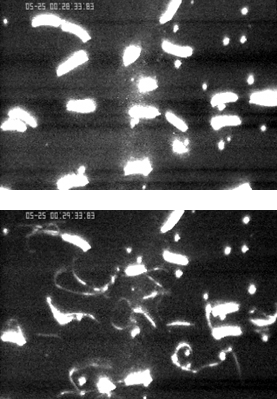Engineering the axonemal nanomachine for nanomounting
Yuuko Wada*, 1, Aaron Bell1, Tyson Valentin1, Raviraja Neelavar1, Sergio Freire2, Jacob Schmidt2, Toshikazu Hamasaki2, Carlo Montemagno2, and Peter Satir1
1Albert Einstein Colledge of Medicine,
Bronx, NY 10461 USA
2UCLA
This is an abstract
for a presentation given at the
11th
Foresight Conference on Molecular Nanotechnology
 |
| Glycerinated his2 Tetrahymena axonemes before and 1 min after 1mM ATP and 1.5mg/ml nagarse (protease) application. 26 days after initial axoneme preparation. In this case, 10 out of 18 axonemes showed sliding. |
|
Cilia and flagella are biological nanomachines that include molecular motors (inner and outer dynein arms) and tracks (outer doublet microtubules - MTs) to which the motors are attached. The 9+2 axoneme (9 outer doublet microtubules which have dynein arms and 2 central singlet microtubules) of the cilium self assembles in cells from ciliates to mammals. When dynein attached to one MT in the axoneme hydrolyzes ATP, it pushes the adjacent MT which results in ciliary / flagellar beating. After preparing axonemes and treating them with protease to break the links between outer doublets, we can get linear sliding movement of microtubules out from the axoneme after addition of ATP.
In order to incorporate axonemes onto manufactured nanomounts for use as force generators, we first tried to find a good method to preserve the axonemes, since fresh axonemes lose their sliding ability within a couple of days on ice. Because glycerinated-muscle models preserve their motile ability over years, we tested glycerination of the axonemes. By placing the axonemes in 25% vol/vol glycerin, we could preserve them for over 3 months at -30°C without freezing. These glycerinated axonemes maintain good sliding ability which allows us to analyze sliding velocity with high time resolution. Glycerin functions as a cryoprotectant and may stabilize the axonemes.
Next we tried to engineer the axonemes for nanomounting. A first step is to attach the axonemes firmly onto a substrate. Since the substrate can be nickel coated, we utilized axonemes from his-tagged tubulin expressing cells (his2; gift from Dr. J. Gaertig). We have tested attaching Ni2+ coated beads in place of the final nanomounts. To engineer a second attachment site, MTs were polymerized from biotinylated tubulin onto the ends of the his2-axonemes. This will permit us to use streptavidin coated cantilevers to attach specifically to one end of the nanomounted engineered axoneme. Deflection of the cantilevers will be used to measure sliding in the axonemes after ATP application.
Supported by DARPA
*Corresponding Address:
Yuuko Wada
Anatomy & Structural Biology
Albert Einstein Colledge of Medicine
1300 Morris Park Avenue
Bronx, NY 10461 USA
Phone: 718-430-4062 Fax: 718-430-8996
Email: [email protected]
Web: http://www.aecom.yu.edu/satir/projects/darpa/
|